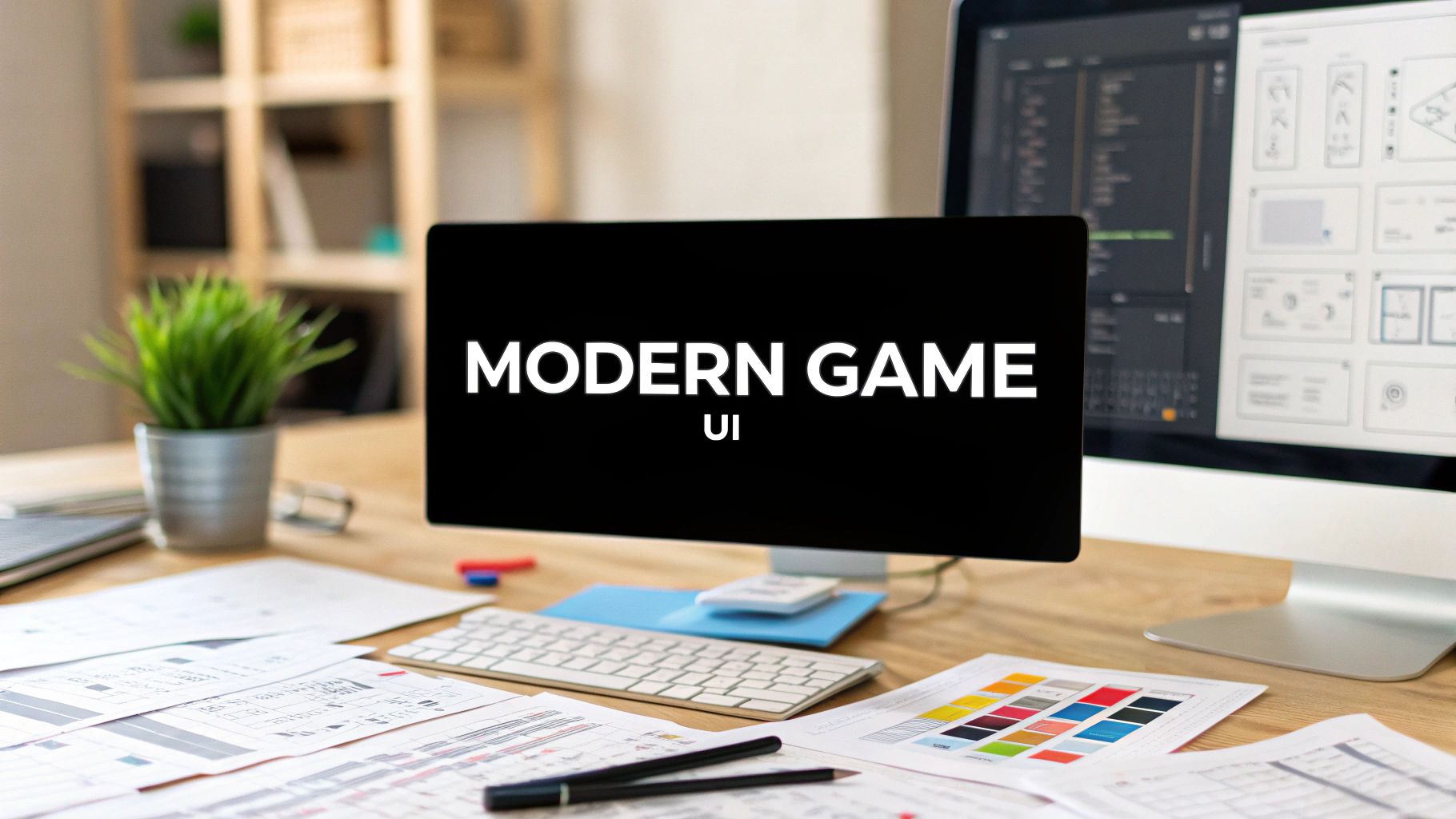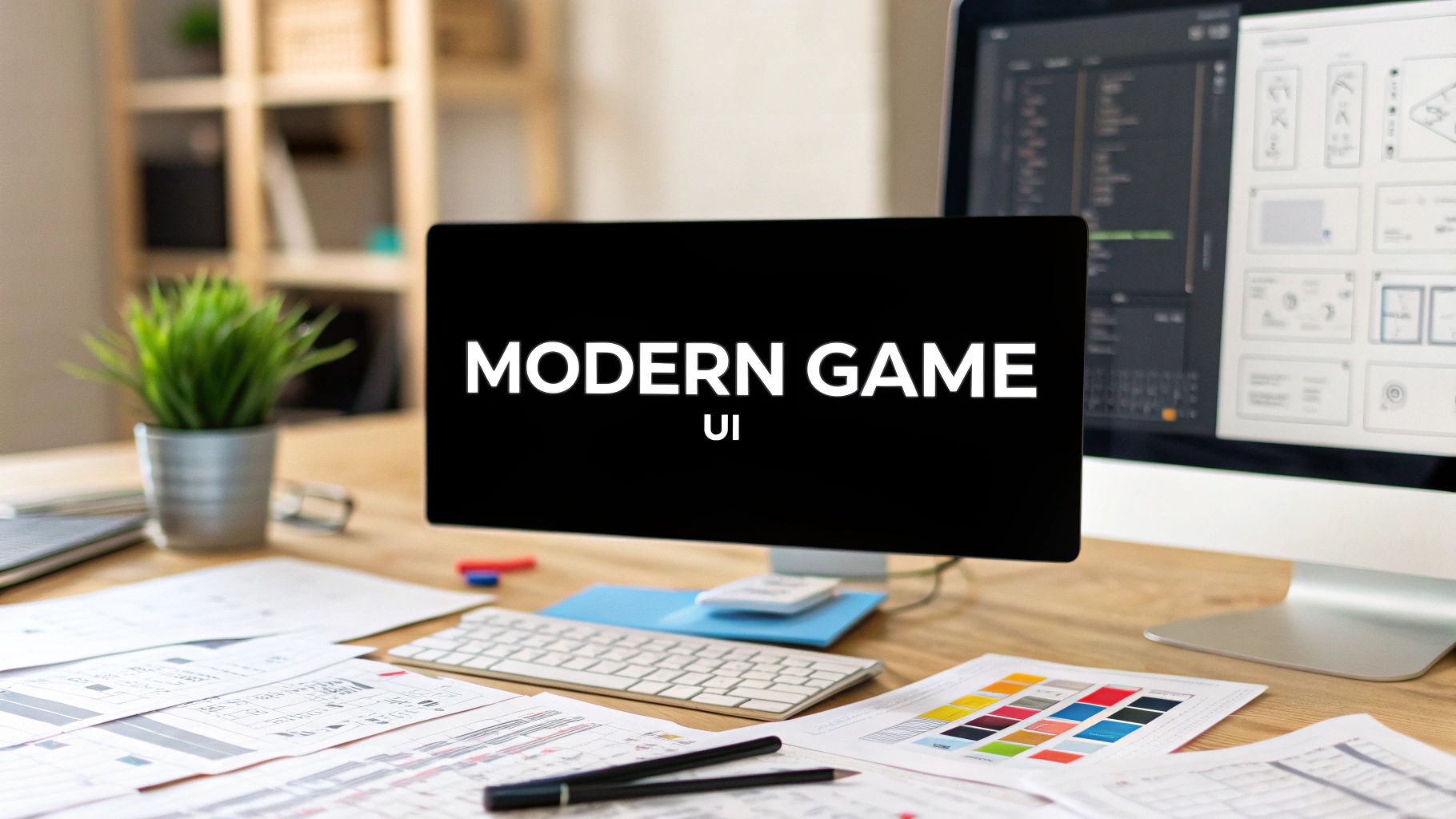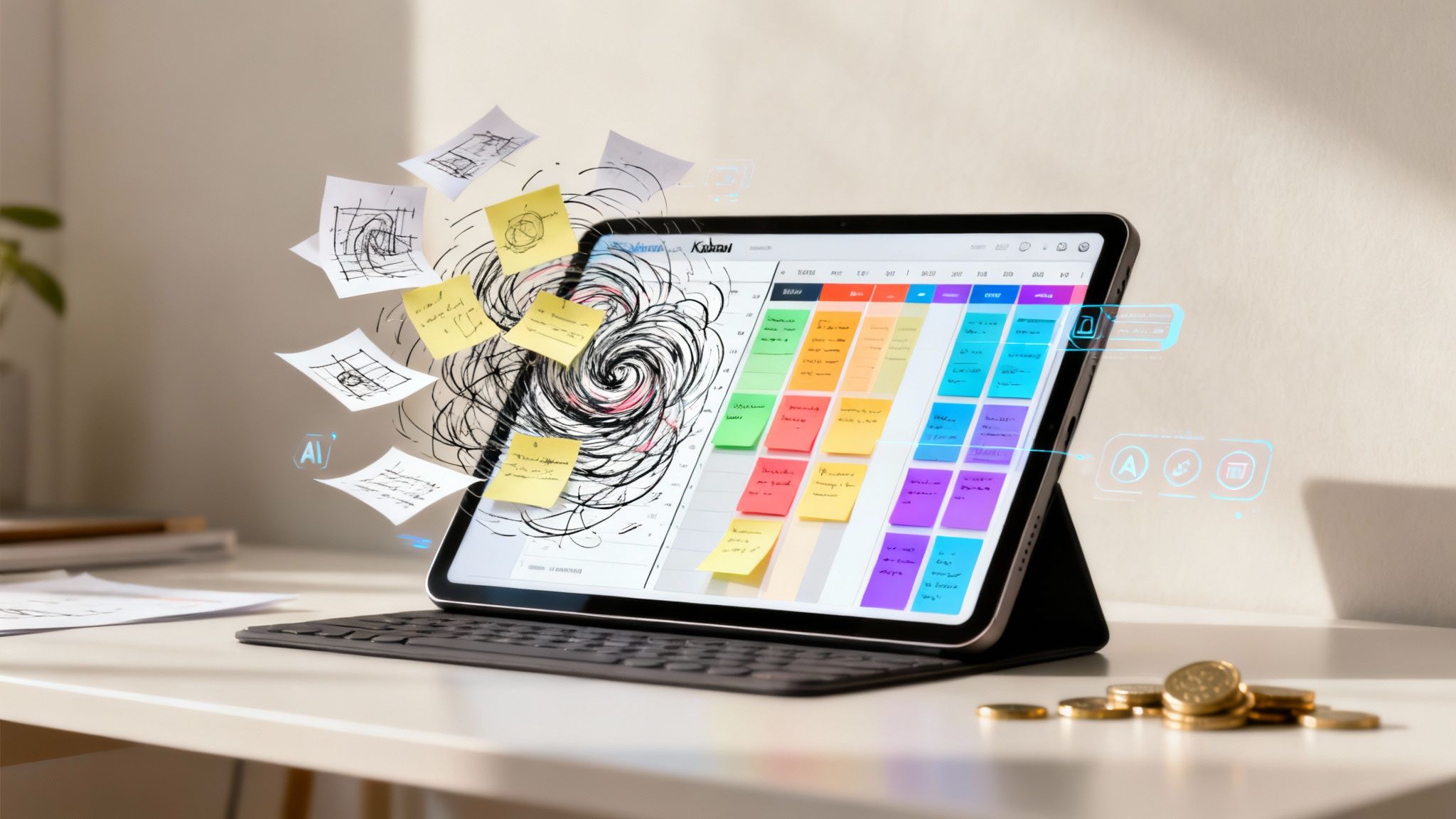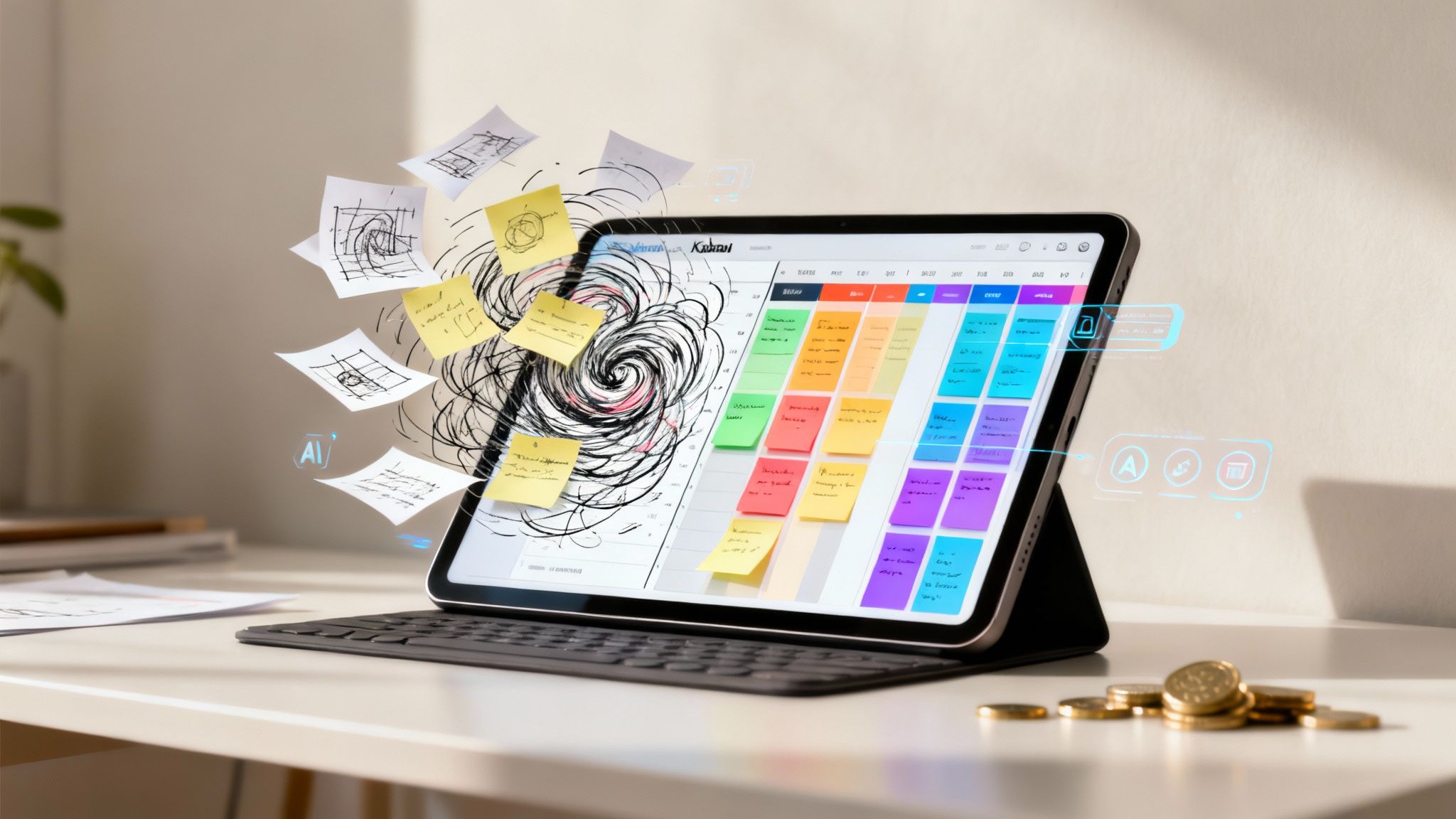At its heart, game interface design is the art of building the bridge between the player and the game. It’s the menus, health bars, maps, and inventory screens—all the visual tools players use to interact with the world you’ve created.
The goal is to present information so clearly and intuitively that players can make decisions with confidence. When it's done right, the interface feels like a natural extension of the game itself, guiding players without ever getting in their way.
From Pixels to Player-Centric UIs
The story of game UI is a story of technology meeting creative problem-solving. It started in an era where every pixel counted and has since grown into a sophisticated discipline focused entirely on the player. Understanding this journey is key to grasping why modern interfaces work the way they do.
Game UI design has evolved right alongside digital technology over the last 50 years. Early games were built on significant constraints. Consider the 1972 arcade classic Pong—its interface was just a few pixelated paddles and a score. The hardware simply couldn't handle more.
These limits forced designers to be direct and highly efficient, a mindset that still holds value today. You can discover more insights about the historical progression of game interfaces and see how these foundational ideas took shape.
The Era of Constraints and Clarity
In the early days of arcades and home consoles, designers had very little to work with. Low-resolution screens, limited color palettes, and minimal processing power meant there was no room for non-essential elements.
This environment demanded absolute clarity. Health bars were simple colored rectangles. Scores were large, blocky numbers. If the interface wasn't instantly understandable, the player was at a disadvantage. These early designs, born out of necessity, established a principle we still adhere to: functionality comes first.
"The primary goal of any game UI is to communicate necessary information to the player with minimal cognitive load. Everything else—aesthetics, immersion, style—is built upon that foundation of clear communication."
These constraints proved to be beneficial. They taught designers the fundamentals of visual hierarchy—how to use contrast, shape, and placement to guide the player's eye to what matters most.
The Leap to Graphical Sophistication
As technology improved, so did the possibilities for UI. The jump from 8-bit to 16-bit systems, and later into 3D, opened the door for interfaces that were not just functional but visually rich. Designers could finally weave artistic style directly into the UI.
But with more power came new challenges. It was tempting to fill the screen with detail, which often overwhelmed the player. The best designers balanced this by adhering to the core principles of clarity while finding new ways to pull players deeper into the game world. This period gave us many UI elements we now consider standard:
- Complex Inventory Systems: We moved from simple lists to grid-based layouts with icons and stats.
- Detailed Mini-Maps: Players got a real-time, top-down view of their surroundings, complete with points of interest.
- Skill Trees and Character Sheets: RPGs introduced deep, menu-driven systems for progression and customization.
The Modern Focus on Player Experience
Today, it is not enough for an interface to simply display information. It has to actively shape the player's experience. A modern UI must be intuitive, accessible, and feel like it truly belongs in the game's world.
Designers now consider the entire player journey, from the moment the game boots up to the final credits. This player-first approach means building adaptable interfaces, letting users resize HUD elements or change the text size.
The ultimate goal is to create a seamless experience where the UI becomes an invisible part of the game. It is there to support the player, reinforce the story, and then get out of the way so the gameplay can take center stage. This journey from basic pixels to a holistic user experience has defined the best practices that guide us today.
Mastering the Core Principles of Game UI
What separates a polished, intuitive interface from a clunky, frustrating one? It all comes down to a handful of core principles that act as the bedrock of great game UI. These aren't just abstract theories; they're the practical guidelines that help designers create interfaces that feel like a natural extension of the game itself.
A truly successful UI works as a silent partner, giving the player exactly the information they need, right when they need it, without ever pulling them out of the moment. Before we get into game-specific design, it’s worth reviewing the essential user interface design best practices that apply everywhere. Think of these as the universal grammar of good design.
The image below breaks down the key principles every game UI designer should follow.
This hierarchy is intentional—it shows how a supportive, player-first interface is built on a solid foundation of well-understood design concepts.
Clarity and Readability First
This principle is non-negotiable. If a player can't instantly read their health bar, check their ammo, or understand an objective, the interface has failed. This simple rule dictates everything from font choices to the icons you design.
Think of your car's dashboard. You need to know your speed and fuel level with a quick glance, not by solving a visual puzzle. The same goes for a game's heads-up display (HUD). Information must be clean, immediate, and impossible to misinterpret.
A player should never have to fight the interface to play the game. The UI’s primary role is to empower the player, not to become another obstacle to overcome.
So, how do you achieve that? Designers focus on a few key elements:
- Legible Typography: Selecting fonts that are crisp and easy to read at different sizes and from a distance is mission-critical.
- Intuitive Iconography: Icons should be visual shortcuts that clearly communicate their function, reducing the need for text.
- High Contrast: Text and other vital UI elements must stand out against the game world, no matter how chaotic the background gets.
Consistency Creates Intuition
Once a player learns what a button does or how a menu works, they expect it to work the same way every single time. Consistency is what builds that trust and makes an interface feel intuitive.
This rule applies to both the visual language and the interaction design. If a red button means "Cancel" in one menu, it should not mean "Confirm" in another. Adhering to these conventions reduces the player's cognitive load, freeing them up to focus on the gameplay instead of relearning the controls.
This also extends to patterns players have learned from other games. Most PC gamers, for instance, expect the Escape key to open a menu. Breaking that kind of unwritten rule without a very good reason can cause instant frustration.
Providing Meaningful Feedback
Every single action a player takes needs a clear and immediate reaction from the interface. This constant feedback loop is what confirms their input was received and shows them the outcome.
Feedback can come in many forms:
- Visual Cues: A button glows or animates when pressed.
- Auditory Cues: A subtle click or swoosh sound confirms a selection.
- Haptic Cues: A vibration in the controller can signal taking damage or a successful interaction.
Without this, players feel disconnected, wondering if the game even registered their button press. That subtle sound when you pick up an item is perfect feedback—effective and reinforcing the player's connection to the game world.
To tie these ideas together, here's a quick reference table summarizing how these principles translate directly into a better player experience.
Key Principles of Game UI Design
Ultimately, a well-designed UI is one the player barely notices because it just works. By grounding your design in these fundamental principles, you ensure the interface serves its true purpose: to support the game, not get in its way.
Adapting Your UI for Different Game Genres
Attempting to use a one-size-fits-all UI for every game is an ineffective approach. Each genre has its own pace, rules, and player expectations. What works for a thoughtful, turn-based RPG would be entirely unsuitable for a fast-paced fighter.
The goal is to design an interface that serves the core gameplay loop, not one that gets in the way. It’s not just about aesthetics; it’s about function. The visual language and information you present must align perfectly with what the player needs to see and do at any given moment.
High-Speed Action vs. Deep Strategy
Consider two extremes: a first-person shooter (FPS) and a grand strategy game. Their UI needs could not be more different because the pace and mental load are worlds apart.
In an FPS like BattleBit Remastered, everything is immediate. Decisions are made in fractions of a second. The heads-up display (HUD) must be minimal and unobtrusive. Players need critical info—ammo, health, mini-map—with a quick glance, never blocking their view. The UI’s sole job is to deliver data fast, with zero distraction. Anything that pulls focus from aiming and moving is a design flaw.
Now, contrast that with a grand strategy game like Crusader Kings III. Here, it’s all about long-term planning, not reflexes. The interface is the game board, filled with dense menus, tooltips, and data-heavy dashboards.
The player's journey in a strategy game happens almost entirely through the UI. It has to be a powerful command center, giving them access to massive amounts of information without feeling overwhelming.
This is where smart game interface design really makes a difference. It organizes layers of complexity into clean, accessible menus, letting players manage entire economies, diplomatic relations, and armies without getting lost.
Immersion in RPGs and Survival Horror
For RPGs and survival horror, the interface does more than just display data—it helps tell the story and build the atmosphere.
In an RPG, the UI is all about player growth and expression. Character sheets, skill trees, and inventory screens are central to the experience. A great RPG menu turns managing loot and spending skill points into a satisfying reward, not a chore.
Survival horror, on the other hand, often uses its UI to create tension. An interface might be deliberately clunky or exist diegetically (as an object in the game world) to make the player feel more vulnerable. When you have to open a physical-looking backpack in real-time while a monster is nearby, the UI becomes part of the suspense. It’s a trade-off: less efficiency for more emotional impact.
UIs in Sports and Simulation Games
Genres like sports and sims also have their own distinct UI needs. In a sports game, the UI needs to look and feel like a real TV broadcast, using familiar graphics for scores and stats to feel authentic. It has to be polished, professional, and readable at a glance during intense gameplay.
New technology is pushing this even further. For instance, developers are now figuring out how to adapt these complex displays for more immersive platforms. You can read more about these challenges in our article on virtual reality sports games.
Ultimately, tailoring your UI to a specific genre is about respecting the player's mindset. Once you understand the core gameplay loop, you can build an interface that feels less like a tool and more like an intuitive extension of the game world itself.
A Modern Game Interface Design Workflow
Knowing the principles is one thing, but putting them into practice is where the process truly begins. A modern game UI design workflow is not a rigid checklist; it's a flexible roadmap. It’s what takes your team from a blank screen to a polished, intuitive interface that players enjoy using.
The objective is to build a process that is both repeatable and collaborative. By breaking the journey into clear phases, you can manage complexity, test your assumptions early, and ensure the final UI feels like a natural part of the game world.
Phase 1: Foundational Research and Wireframing
Every great UI starts by answering a simple question: what does this need to do? This first phase is all about discovery. You're figuring out who the player is, what information they need at any given moment, and how the UI can support the core gameplay. Visuals are not the focus here—this is pure function.
You'll dig into the game's mechanics and even look at how similar games in the genre handle their interfaces. The main deliverable here is a set of low-fidelity wireframes. Think of them as the architectural blueprints for your UI. They are simple, blocky layouts showing where elements like the health bar, mini-map, and menus will live. It’s all about establishing the core structure without getting distracted by colors or fonts.
Phase 2: Mockups and High-Fidelity Prototypes
Once everyone agrees on the blueprint, it's time to bring it to life. This is the visual design stage where designers create high-fidelity mockups that define the UI's entire look and feel. This is where your typography, color palettes, icons, and even motion design choices come together to create a visual language that fits the game’s universe.
From those polished mockups, the team builds an interactive prototype. This is not just a static image; it's a clickable, semi-functional version of the UI. It lets you simulate how a player would actually move through menus and interact with different screens.
An interactive prototype is the single most valuable tool for early validation. It allows the entire team—and, crucially, test users—to experience the flow of the interface long before any production code is written.
This step is absolutely critical for identifying usability issues. A button might look great in a static image but feel clunky or hard to find in a hands-on prototype. Catching these problems early is what separates a decent interface from a truly great one.
Phase 3: User Testing and Iteration
No design survives first contact with real players. The user testing phase is where your assumptions get put to the test. This needs to happen early and often, using that interactive prototype to gather honest feedback.
Good user testing is about observing what players do, not just asking what they think. You're trying to answer a few key questions:
- Task Completion: Can they find the inventory and equip an item without guidance?
- Information Clarity: Do they instantly understand what each icon or stat means?
- Navigation Flow: Are there any menus where they get stuck, frustrated, or lost?
The feedback you collect here fuels the design loop. Based on what you see, the team goes back to the prototype, smooths out the rough spots, and polishes the experience. You repeat this cycle of testing and refining until the interface feels completely natural.
Phase 4: Leveraging AI for Responsible Asset Creation
In a modern workflow, AI tools can be an incredible creative partner. Teams can use them to generate dozens of icon variations in minutes, explore different layout concepts, or create placeholder art for prototypes. The key is to use this technology responsibly while maintaining full creative control. To get a better handle on this, our guide on the role of AI in game development offers a deeper look into building an efficient and compliant process. It’s about accelerating production without sacrificing your game's unique artistic vision.
Beyond the design work itself, a huge part of a modern designer's job is showcasing those skills, which means knowing how to craft a strong UX portfolio.
Weaving Your Interface into the Game World
The best interfaces don't feel like a separate layer placed on top of a game. They feel like they belong there, a genuine part of the world itself. This is where game interface design stops being about just showing information and starts telling a story.
When you weave UI elements directly into the gameplay and narrative, you pull the player deeper into the experience. The line between the game world and the information the player needs melts away. Instead of a floating health bar, perhaps a character's armor starts glowing red as they take damage. This is not just for style; it's a design choice that makes necessary data part of the story.
Understanding Diegetic Design
This whole idea revolves around one core concept: the difference between diegetic and non-diegetic UI. The terms may sound academic, but the idea is simple and incredibly powerful for designers.
- Diegetic UI: These are the elements that exist inside the game's world. Both the player and the game characters can see and interact with them. This is designed for maximum immersion.
- Non-Diegetic UI: This is your traditional interface that lives outside the game world, visible only to the player. That classic health bar or ammo counter in the corner of the screen is non-diegetic.
A classic example of diegetic design is the health meter built right into Isaac Clarke’s RIG suit in the Dead Space series. It’s not just a bar; it's an in-world piece of tech that tells you everything you need to know while reinforcing the gritty, vulnerable sci-fi atmosphere.
When to Use a Traditional Interface
As effective as diegetic design is, it’s not a universal solution. Sometimes, a conventional non-diegetic HUD is simply better and more efficient. It’s all about understanding the trade-offs.
A diegetic map that a character has to physically pull out and look at adds a ton of realism. But in a fast-paced shootout, it’s clumsy and slow. A transparent mini-map in the corner, however, gives you instant information when you need it most. The best game interface design finds a smart balance, using diegetic elements to build atmosphere and non-diegetic ones for pure, functional clarity.
A thoughtful mix of diegetic and non-diegetic elements lets designers craft an experience that is both immersive and highly functional, serving the game's narrative and mechanical needs in equal measure.
This kind of interface complexity was not always possible. The major leap forward came with the rise of graphical user interfaces (GUIs) in the 1990s. As CPUs got faster and graphics cards more powerful, developers could finally move beyond simple text displays and create visuals that balanced both aesthetics and function. You can trace many modern game UI conventions back to those early days, as detailed in this history of the graphical user interface on Wikipedia.
Turning UI into a Storytelling Tool
Ultimately, folding your UI into the game world is about making every single element count for more than just its function. It’s about asking yourself: how can this interface reinforce the game’s core themes?
Is your game set in a high-tech future? Holographic displays and AR overlays are a natural fit. A gritty fantasy world? Perhaps health is shown through magical tattoos that fade with each hit. The world itself has to support these choices. Our guide to creating compelling 3D gaming backgrounds can give you some great ideas for building environments that work hand-in-hand with your UI.
When you start thinking this way, you're no longer just designing menus and icons. You're building a more believable, engaging world where every single piece—including the interface—helps tell the story.
Answering Your Top Game Interface Questions
When you get deep into game UI design, a few questions often come up. Whether you're a seasoned designer or a developer wearing many hats, it's easy to get tangled in the details.
Let’s clarify some of the most common points of confusion with a quick-reference FAQ.
What's the Real Difference Between UI and UX?
This question comes up constantly, and it’s the most important distinction to understand.
UI (User Interface) is the collection of elements players see and touch. It’s the buttons, the health bars, the inventory screens, the icons. It's the tangible, visual layer of your game's controls.
UX (User Experience) is how it feels to use all of those elements. Is the menu navigation seamless or frustrating? Does the HUD give players the info they need at a glance, or does it cause confusion? It is possible to have a beautiful, aesthetically pleasing UI that delivers a poor UX.
Great game interface design happens when both work together in harmony.
How Can AI Actually Help with UI Design?
AI tools are becoming a significant creative accelerant, especially in the concepting phase. Instead of spending a day mocking up ten different button styles, you can prompt an AI to generate dozens of variations in minutes. It is excellent for ideating icons, building out style sheets, or even generating functional prototypes much faster than by hand.
This does not replace designers. On the contrary, it frees them from repetitive work. All that time saved from manually creating assets can be reinvested where it matters most: user testing, refining interaction flows, and ensuring the UI truly serves the game's artistic vision.
Think of AI as a powerful assistant that handles repetitive tasks so the human expert can focus on the big picture.
What Are the Biggest Mistakes to Avoid?
I see three common pitfalls that are easy to fall into but can detract from a player's experience every time.
- Too Much on Screen: This is a classic mistake. Cluttering the HUD with every possible piece of information overwhelms and distracts players from the actual game. Less is almost always more.
- Inconsistency: If a green button means "Go" in one menu, it should not mean "Delete Save File" in another. When visual language and interaction patterns change randomly, it forces the player to re-learn the rules, which is frustrating. Consistency is what builds intuition.
- Forgetting About Accessibility: Designing for a single "ideal" player is a significant misstep. Failing to include options like scalable text, colorblind modes, or remappable controls isn't just inconsiderate—it can prevent a large portion of your potential audience from enjoying the game.
Good design is inclusive design. Accessibility is not a feature you add at the end; it's a fundamental part of the process that makes your game better for everyone.
What Is a "Diegetic" Interface?
A diegetic interface is one that exists within the game's world, visible to both the player and the characters. It’s a technique for deepening immersion by weaving the UI directly into the environment and narrative.
The most famous example is the health bar on Isaac Clarke’s suit in Dead Space. It’s a vital piece of UI, but it also feels like a functional part of his gear. Another is when a character in Far Cry 2 physically pulls out a crumpled map to navigate.
Instead of a floating, disconnected menu, the interaction becomes part of the world-building. It's a sophisticated way to tell a story through design, making players feel more connected by removing artificial-feeling overlays.
Ready to accelerate your creative workflow? Bring your game assets to life with Virtuall. Turn your ideas from text or images into high-quality 3D models in seconds, manage projects with intuitive collaboration tools, and maintain full creative control. Discover how Virtuall can empower your team today.











